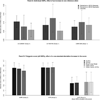Replicability and robustness of genome-wide-association studies for behavioral traits
- PMID: 25287667
- PMCID: PMC4375246
- DOI: 10.1177/0956797614545132
Replicability and robustness of genome-wide-association studies for behavioral traits
Abstract
A recent genome-wide-association study of educational attainment identified three single-nucleotide polymorphisms (SNPs) whose associations, despite their small effect sizes (each R (2) ≈ 0.02%), reached genome-wide significance (p < 5 × 10(-8)) in a large discovery sample and were replicated in an independent sample (p < .05). The study also reported associations between educational attainment and indices of SNPs called "polygenic scores." In three studies, we evaluated the robustness of these findings. Study 1 showed that the associations with all three SNPs were replicated in another large (N = 34,428) independent sample. We also found that the scores remained predictive (R (2) ≈ 2%) in regressions with stringent controls for stratification (Study 2) and in new within-family analyses (Study 3). Our results show that large and therefore well-powered genome-wide-association studies can identify replicable genetic associations with behavioral traits. The small effect sizes of individual SNPs are likely to be a major contributing factor explaining the striking contrast between our results and the disappointing replication record of most candidate-gene studies.
Keywords: behavior genetics; educational attainment; genome-wide association study; individual differences; population stratification.
© The Author(s) 2014.
Conflict of interest statement
The authors declared that they had no conflicts of interest with respect to their authorship or the publication of this article.
Figures

References
-
- Campbell CD, Ogburn EL, Lunetta KL, Lyon HN, Freedman ML, Groop LC, Hirschhorn JN. Demonstrating stratification in a European American population. Nature Genetics. 2005;37(8):868–872. - PubMed
Publication types
MeSH terms
Grants and funding
LinkOut - more resources
Full Text Sources
Other Literature Sources

